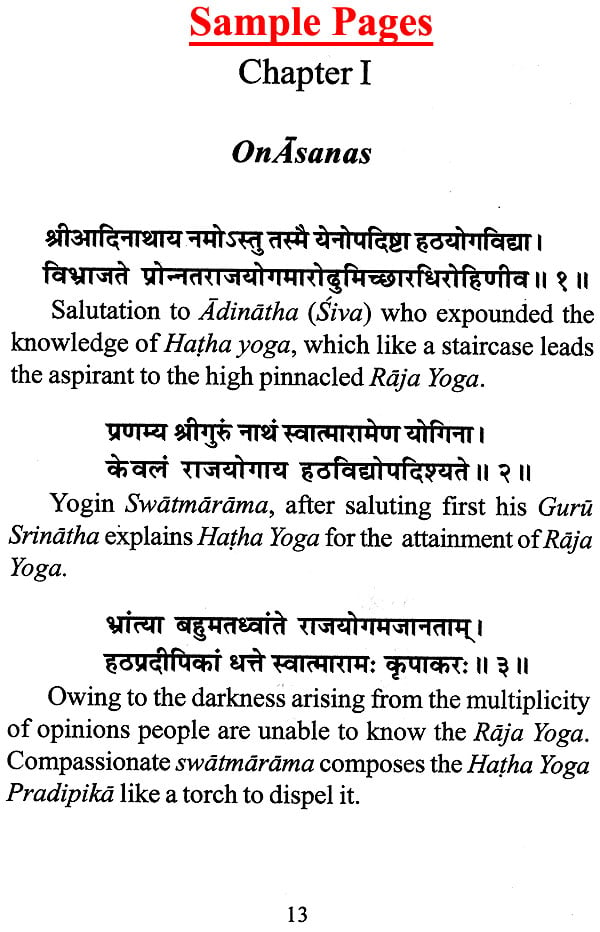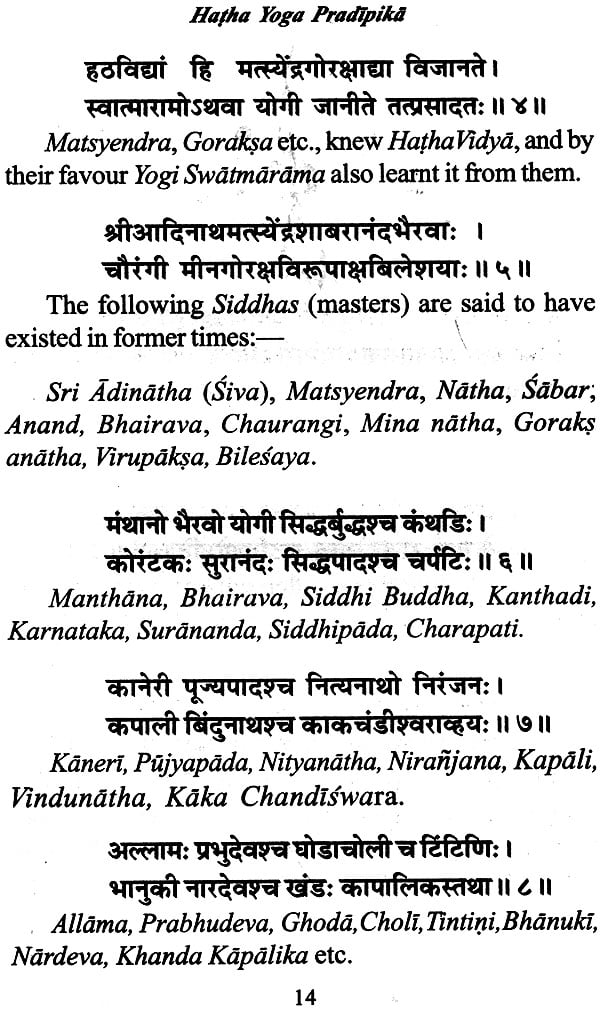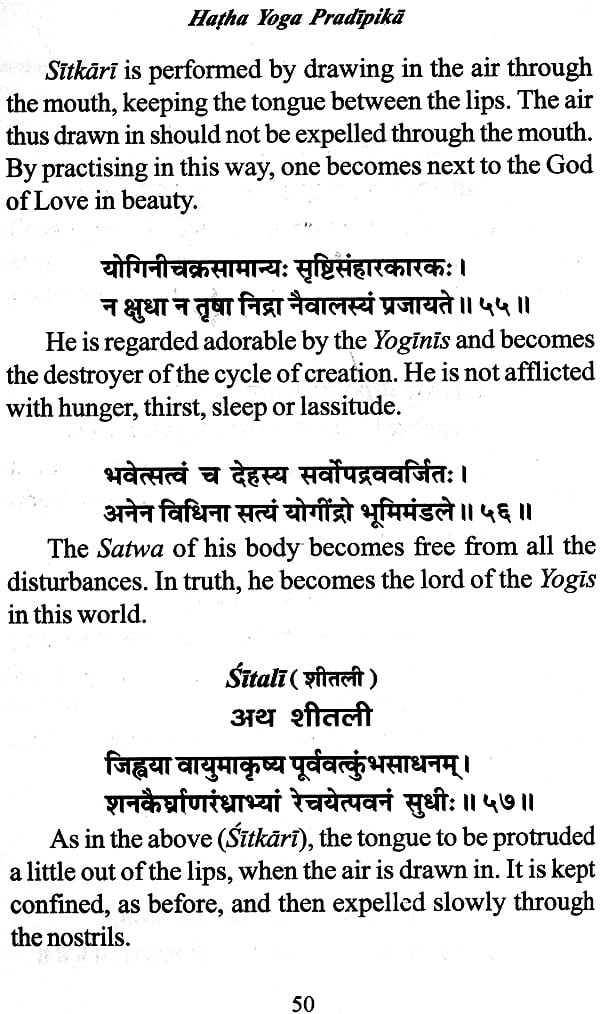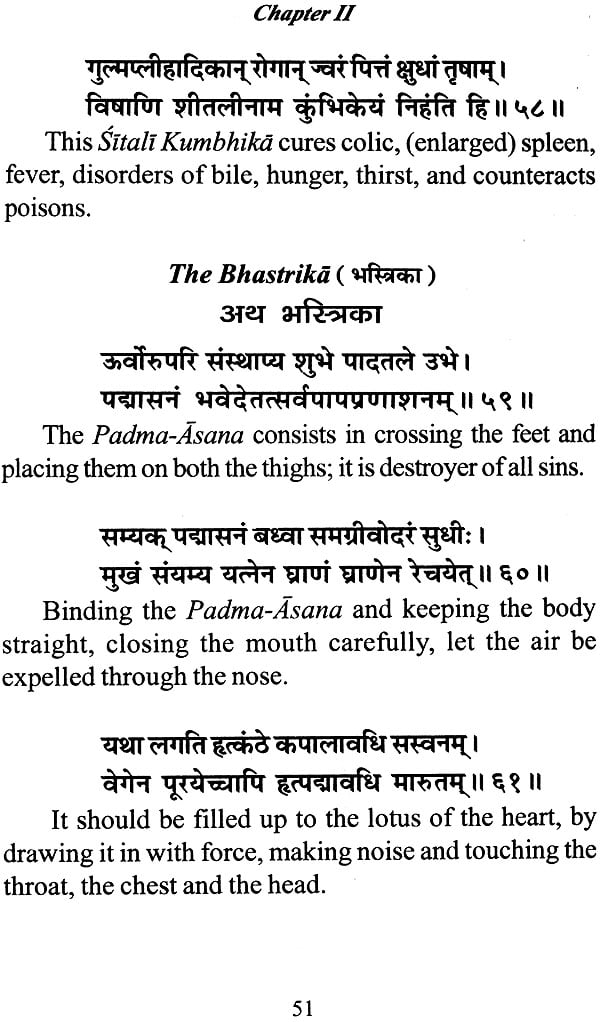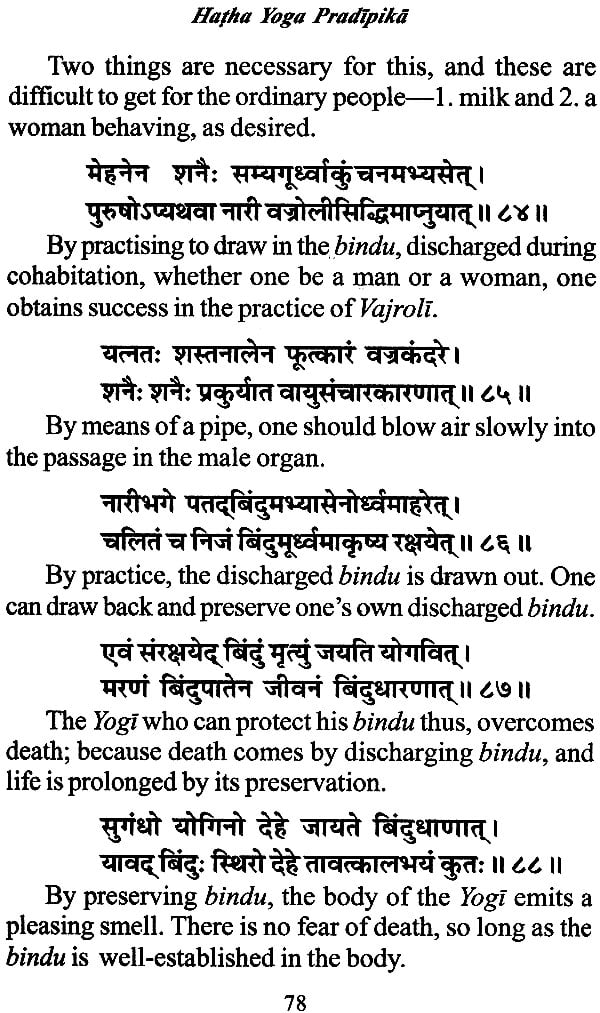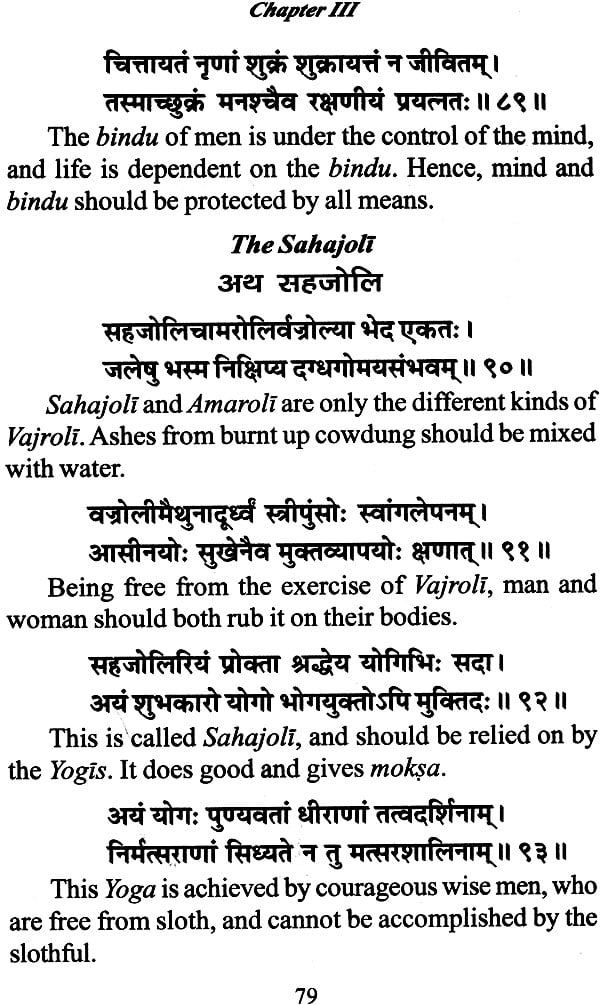
Hath Yoga Pradipika
Book Specification
| Item Code: | NAE066 |
| Author: | Pancham Singh |
| Publisher: | Indian Mind, Varanasi |
| Language: | (Text with English Transiation) |
| Edition: | 2012 |
| ISBN: | 8186117156 |
| Pages: | 112 |
| Cover: | Paperback |
| Other Details | 7.0 inch X 4.5 inch |
| Weight | 100 gm |
Book Description
The Hatha Yoga Pradipika is an important text in which the essential of yoga is explained. It explains in clear terms the asanas, pranayama, mudras, and the samadhi which are essential in the practice of yoga. It describes the stages and the correct methods for practicing yoga. Hatha yoga Pradipika attempts to reconcile the Raja yoga of Patanjali with Hatha yoga. Hatha is considered to be made up of syllables ha, meaning the moon and the meaning the sun. It corresponds to the breath which flows though the left and the right nostrils. Hatha-yoga is the preliminary step and ends of Raja-yoga consciously or unconsciously. The saivagama urges not to give up to practice of asana and Pranayama in order to keep the body beautiful and healthy. It also discusses deep philosophy underlying the yoga. It is also a manual of instructions for the students of yoga.
The importance of this text for teacher and student of yoga alike cannot be overestimated as this treatise is of immense practical value. The present work contains the original Sanskrit text and its translation into English along with an Introduction.
There exists at present a good deal of misconception with regard to the practices of the Hatha Yoga. People easily believe in the stories told by those who themselves heard them second hand, and no attempt is made to find out the truth by a direct reference to any good treatise. It is generally believed the six practices, in Hatha Yoga are compulsory on the student and that besides being dirty, they are fraught with danger to the practiser. This is not true, for these practices are necessary only in the existence of impurities in the Nadis, and not otherwise.
There is the same amount of misunderstanding with regard to the Pranayama. People put their faith implicitly in the stories told them about the dangers attending the practice, without even taking the trouble of ascertaining the fact themselves. We have been inspiring and expiring air from our birth, and will continue to do so till death; and this is done with the help of any teacher. Pranayama is nothing but properly regulated form of the otherwise irregular and hurried flow of air, without using much force or undue restraint; and if this is accomplished by patiently keeping the flow slow and steady, there can be no danger. It is the impatience for the Siddhis which cause undue pressure on the organs, and thereby causes pains in the ears, the eyes, the chest, etc. If the three bandhas be carefully performed while practicing the Pranayama, there is no possibility of any danger.
There are two classes of students of Yoga (1) those who study it theoretically; (2) those who combine the theory with practice.
Yoga is of very little use, if studied theoretically. It was never meant for such a study. In its practical form however, the path of the student is beset with difficulties, the books on Yoga give instructions so far as it is possible to express the methods in words, but all persons, not being careful enough to follow these instructions to the very letter, fail in their object. Such persons require a teacher verses in the practice of Yoga. It is easy to find a teacher who will explain the language of the books, but this is far from being satisfactory. For Instance, a Pandit without any knowledge of the science of Materia Medica will explain as or an enemy of thorns i.e. shoes, while it is in reality the name of a medicinal plant.
The importance of a practical Yogi as a guide to a student of Yoga cannot be overestimated; and without such as teacher it is next to impossible for him to achieve anything. The methods followed by the founders of the system and followed ever afterwards by their followers, have been wisely and advisedly kept secret; and this is not without deep meaning. Looking to the gravity of the subject and the practices which have a very close relation with the vital organs of the human body, it is of paramount importance that the instructions should be received by students of ordinary capacity, through a practical teacher only, in order to avoid any possibility of mistake in practice. Speaking broadly, all men are not equally fitted to receive the instructions on equal terms. Man inherits on birth his mental and physical capitals, according to his actions in past births, and has to increase them by manipulation, but there are, even among such, different grades. Hence, one cannot become a Yogi in one incarnation.
There are men who, impelled by the force of their actions of previous births, go headlong and accomplish their liberation in a single attempt; but others have to earn it in their successive births. If the student belongs to one of such souls and being earnest, desires from his heart to get rid of the pains of birth and death, he will find the means too. It is well-known that a true Yogi is above temptations and so to think that he keeps his knowledge secret for selling it to the highest bidder is simply absurd. Yoga is meant for the good of all creatures, and a true Yogi is always desirous of benefitting as many men as possible. But he is not to throw away this precious treasure indiscriminately. He carefully chooses its recipients, and when be finds a true and earnest students, who will not trifle with this knowledge, he never hesitates in placing his valuable treasure at the disposal of the man. What is essential in him is that he should have a real thirst for such knowledge-a thirst which will make him restless till satisfied; the thirst that will make him blind to the world and its enjoyments. He should be , in the short, fired with or desire for emancipation. To such a one, there is nothing dearer than the accomplishment of this object. A true lover will risk his very life to gain union with his beloved like Tulasidas. A truelove will see everywhere, in every direction, in every tree and leaf, in every blade of grass his own beloved. The whole of the world, with all its beauties, is a dreary waste in his eyes, without his beloved. And he will court death, fall into the mouth of gaping grave, for the sake of his beloved. The student whose heart burns with such intense desire for union with Paramatma is sure to find a teacher and through him he will surely find Him. It is tried experience that Paramatma will try to meet you half way, with the degree of intensity with which you will go to meet Him. Even He Himself will become your guide, direct you on the road to success, or put you on the track to find a teacher, or lead him to you.
It is the half-hearted who fail. They hold their worldly pleasures dearer to their hearts than their God, and therefore He in His turn does not consider them worthy of His favors.
The Atma will choose you its abode only if considers you worthy of such a favours, and not otherwise. It is therefore necessary that one should first make oneself worthy of His acceptance. Having prepared the temple (your heart) well fitted for His installation there, having cleared it of all the impurities which stink and make the place unsuitable for the highest personage to live in and having decorated it beautifully with objects as befit that Lord of the creation , you need not wait long for Him to adorn this temple of yours which you have taken pains to make it worthy of Him. If you have done all this. He will shine in you in all His Glory. In your difficult moments, when you are embarrassed, sit in a contemplative mood, and approach your Parama Guru submissively and refer your difficulties to Him. He is the guru of the ancient , for He is not limited by time. He instructed the ancients in bygone times, like a Guru, and if you have been unable to find a teach in the human form, enter your inner temple and consult this Great Guru who accompanies you everywhere, and ask Him to show you the way. He knows best what is best for you. Unlike mortal beings. He is beyond the past and the future, will either send one of His agents to guide you or lead you to one and put you on the right track. He is always anxious to teach the earnest seekers, and waits for you to offer Him an opportunity to do so. But if you have not done your duty and prepared yourself worthy of entering His door, and try to gain access to His presence, laden with your unclear burden, stinking with Kama, Krodha, Lobha Moha, be sure. He will keep you off from Him.
The Asanas are a means of gaining steadiness of position and help to gain success in contemplation, without any distraction of the mind. If the position of the mind. If the position be not comfortable, the slightest inconvenience will draw the mind away from the Laksya (aim) and so no peace of mind will be possible till the posture has ceased to cause pain by regular exercise.
Of all the various methods for concentrating the mind, repetition of Pranava or Ajapa japa and contemplation on its meaning is the best. It is impossible for the mind to sit idle even for a single moment, and therefore in order to keep it well occupied and to keep other antagonistic thoughts from entering it, repetition of Pranava should be practiced. It should be repeated till Yoga Nidra is induced which, when experienced, should be encouraged by slackening all the muscles of the body. This will fill the mind with sacred and divine thoughts and will bring about its one-pointedness, without much effort.
Anahata Nada is awakened by the exercise of Pranayama. A couple of weeks practice with 80 pranayamas in the morning and the same number in the evening will cause distinct sounds to be heard; and as the practice will go on increasing, varied sounds become audible to the practiser. By hearing these sounds attentively one gets concentration of the mind, and thence Sahaja Samadhi. When Yoga sleep is experienced, the student should give himself up to it and make no efforts to check it. By and by, these sounds become subtle and they become less and less intense, so the mind loses it waywardness and becomes calm and docile; and, on this practice becoming well-established, Samadhi becomes a voluntary act. This is, however, the highest stage and is the lot of the favoured and fortunate few only.
During contemplation one sees, not with his eyes, as he does the objects of the world, various colours, which the writers on Yoga call the colours of the five elements. Sometimes stars are seen glittering, and lightning flashes in the sky. But these are all fleeting in their nature.
At first these colours are seen in greatly agitated waves which show the unsteady condition of the mind; and as the practice increases and the mind becomes calm, these colours –waves become steady and motionless and appear as one deep ocean of light. This is the ocean in which one should dive and forget the world and become one with his Lord-which is the condition of highest bliss.
Faith in the practices of Y9oga, and in one’s own powers to accomplish what others have done before, is of great importance to insure speedy success. I mean ”faith that will move mountains.” Will accomplish anything, be it howsoever difficult. There is nothing which cannot be accomplished by practice.
Through practice success is obtained; through practice one gains liberation Perfect consciousness is gained through practice; Yoga is attained through practice; success in mudras comes by practice. Though practice is gained success in pranayama. Death can be evaded of its prey through practice, and man becomes the conqueror of death by practice. And then let us gird up our loins, and with a firm resolution engage in the practice, and the success must be ours. May the Almighty Father, be pleased to shower His blessings on those who thus engage in the performance of their duties.
| Introduction | 5 | |
| Chapter One: On Asanas | 13-30 | |
| Asanas | 17 | |
| Swastika-Asana | 18 | |
| Gomukha -Asana | 18 | |
| Virasana | 18 | |
| Kurmasana | 18 | |
| Kukkuta-Asana | 19 | |
| Uttana Kurma-Asana | 19 | |
| Dhanur-Asana | 19 | |
| Matsya-Asana | 20 | |
| Paschima Tana | 20 | |
| Mayura-Asana | 21 | |
| Sava-asana | 21 | |
| The Siddha-asana | 22 | |
| Padmasana | 24 | |
| The Simhasana | 26 | |
| The Bhadrasana | 26 | |
| Chapter Two: On Pranayama | 31-56 | |
| Method of Performing Pranayama | 32 | |
| The Dhauti | 37 | |
| The Basti | 38 | |
| The Neti | 39 | |
| The Trataka | 39 | |
| The Nauli | 40 | |
| The Kapala Bhati | 40 | |
| Gaja Karani | 41 | |
| Manomani | 42 | |
| Different kinds of kumbhakas | 42 | |
| Sorya Bhedana | 49 | |
| Ujjayi | 49 | |
| Sitali | 50 | |
| The Bhastrika | 51 | |
| The Bhremari | 53 | |
| The Murchha | 53 | |
| The Plavini | 54 | |
| Chapter Three : On Mudras | 57-83 | |
| The Maha Mudra | 59 | |
| The Maha Bandha | 61 | |
| The Maha Vedha | 63 | |
| The Khechari | 64 | |
| Uddiyana Bandha | 71 | |
| Mula Bandha | 72 | |
| The Jalandhara Bandha | 74 | |
| The Viparita Karani | 76 | |
| The Vajroli | 77 | |
| The Sahajoli | 80 | |
| The Amaroli | 80 | |
| The Sakti Chalana | 80 | |
| Chapter Four:On Samadhi | 87-111 | |
| Sambhavi Mudra | 94 | |
| The Unmani | 95 | |
| The Taraka | 96 | |
| The Khechari | 97 | |
| Arambha Avastha | 102 | |
| The Ghata Avastha | 103 | |
| The Parichaya Avastha | 104 |
